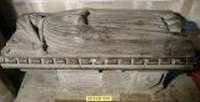 Click on
Click onThumbnail
for
3 photos+
The following is from Archæologia Æliana, 4th series VII, Mediæval Effigies in Northumberland, 1930, C H Hunter Blair, p.26:
XXXI. Now within his chantry chapel, on the north side at the east end of the chancel, restored to its proper place after many removals.
Person: Prior Rowland Leschman (1480–1491) [now believed to be 1480–1499].
Material: Sandstone, in good condition.
Effigy: Upon an embattled slab on the top of its high tomb. Beneath the cloak is an inner pleated robe with tight sleeves, his bare hands are joined in prayer, the hood is partly pulled over the face. The feet, in broad toed shoes, are without a rest.
Armorials: On the east panel on the south side of the tomb is a shield charged with the initials of the prior [rl], placed saltireways.
1776: “Many ancient tombs are here: within the Chancel is the recumbent effigy of an Ecclesiastic hooded, on a table monument of black marble, in relief; at the foot, a shield with uncommon arms, or rather an emblematical device to denote mortality, being the resemblance of cross bones. The people who keep the doors, say it is the tomb of Prior Richard, an Historian of the 12th century. He was some time a Monk here, and occurs Prior AD 1153. The device on the shield, if it is presumed to be the tomb of Richard, will then appear to be the letters [rl] placed one over the other.” [Hutchinson, ‘A View of Northumberland …’ pt.1 p.95]
1823: “The most ancient table monument in the church is now placed exactly in front of the shrine on the north side of the centre aisle of the choir. This is not its original situation. It now covers another tomb on which it rests, and this impropriety of place has caused much confusion in the accounts respecting it. Its description is simple. The figure of a monk—hooded with his hands clasped in the attitude of prayer. It is commonly called the tomb of Prior Richard, whom this figure is supposed to represent. … It is probable that the monument on which the prior's effigy rests is the tomb of Sir J Fenwick.” [Wright, ‘An Essay …’ p.90–91]
Leschman's chantry (now, since 1908, believed to be in its original position) had been moved into the north chancel aisle in the 18th century, and in 1856 into the south transept. The tomb & effigy have also moved around, and have not always been inside the chantry.